
Eight reasons to choose Spanish haute cuisine
Preparing your trip: On your list of basic travel must-dos, along with visiting the most noteworthy monuments and museums, add the names of the typical dishes you want to (must) sample, recommended restaurants and gastronomic products you want to bring home in your suitcase. If you are a foodie, Spain is the country for you. And if you are seeking a complete experience where the cuisine is elevated to an art form and eating is translated into a pleasure for the five senses, then Spain will captivate you. Here we give you five reasons why you'll fall in love with its dishes, its chefs and its restaurants. Make a note and start packing your case.
Debe activar Javascript para poder utilizar este servicio
-
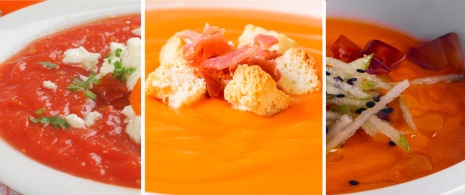
A cuisine that’s open to the world
Current Spanish cuisine is the result of centuries of evolution, defined by its geographical characteristics and the country’s deep-rooted history. On the one hand, this translates into maximum quality and a large bounty of culinary raw materials. On the other, the passage of the different peoples and civilisations through the Iberian Peninsula have left rich and varied influences on Spanish gastronomy: from the sauces introduced by the Phoenicians to the famous olive oil, inherited from the ancient Greeks. Did you know that Spanish gazpacho has Arabic roots? Now, without losing sight of its origins, our country’s high-end cuisine also feeds off international cuisines, with dishes loaded with nuances and intelligent combinations.
-
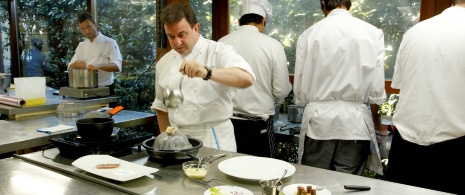
Spanish creativity: from the technique to the product
At the end of the 90s the creativity of a new generation of Spanish chefs crossed frontiers and put Spanish haute cuisine firmly on the global gastronomic map, where it continues to set a precedent. Names like Juan Mari Arzak, Martín Berasategui and Ferran Adrià started to develop a culinary style that offered a complete sensory experience: enjoying the food with the five senses, including emotions. The revolution has reached the technique: the classic “made in Spain” products such as Iberian cured ham or olive oil were reinvented into deconstructed dishes, into innovative textures such as foams or spheres, or blended with elements that had been unthinkable until then in culinary uses, such as liquid nitrogen; and also with the ingredients: new gastronomic products like tender pine nuts (the fruit of the pine that can only be obtained at a specific moment of maturity during the year) or, in the 2010s, plankton. The result is a unique, groundbreaking, surprising and constantly evolving cuisine.
-
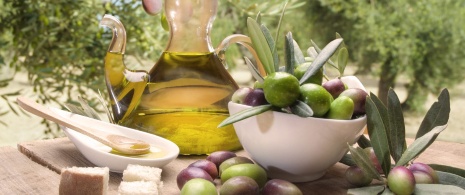
Mediterranean diet
Evolutions and revolutions aside, there is a part of the traditional Spanish cuisine that remains intact and provides a solid base that has permitted the spectacular development of this haute cuisine – the Mediterranean diet. Declared to be an Intangible Cultural Heritage of Humanity Intangible by UNESCO in 2010 and provider of proven health and wellness benefits, the Mediterranean Diet is engrained in the DNA of Spanish cuisines and the people responsible for executing them take increasingly more care to safeguard their healthy essence.
-

Perfect pairings
In Spain you can’t mention gastronomy without making reference to the wine. And the different fine dining creations in our country are conceived with a view to future pairing possibilities. In fact, top Spanish restaurants offer complete gourmet experiences where their Michelin-starred dishes are paired with different wines, perfectly selected to complement each course or stage in the tasting.
-

Sustainable
Current Spanish haute cuisine will also convince you of its environmental commitment. Seasonal and local products are the basis for the menus of Spain's most prestigious restaurants and there are even some, such as the one owned by Ángel León in Cadiz, the so-called “chef of the sea”, or the cuisine offered by Eneko Atxa at his Basque establishment, where sustainability has become the very essence and identity of their culinary projects: from the raw ingredients or preparation processes to the architecture and energy efficiency of the buildings they are housed in.
-
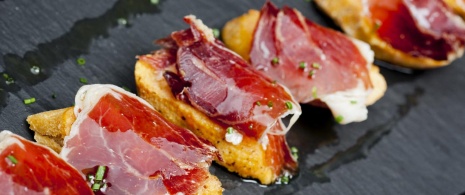
The verb “tapear” (to eat tapas)
Its origin is not completely clear but there are many theories and legends about why the name tapa was given to this Spanish custom of accompanying a drink with a little dish of food. But what is clear is that the tapa has become a very distinctive and personal element of the Spanish gastronomy. What’s more, over time it has become increasingly sophisticated, making it one of the most appealing ways to sample the country's haute cuisine: on tasting menus made up of several small, perfectly presented dishes. Miniature haute cuisine that delivers a genuine gastronomic message.
-

Michelin-starred chefs
According to its prestigious international ranking, the quality and creativity of Spanish haute cuisine has made it one of the very best in the world. One of the most renowned, the Michelin Guide, awards stars to 306 Spanish restaurants in 2026: 253 with one star, 37 with two stars and an impressive 16 restaurants with three Michelin stars, the highest accolade, which means that eating at these restaurants makes the journey more than worthwhile, and positions Spain second on the list of “three-starred” countries in Europe. Four restaurants in our country are in “The World's 50 Best”, another of the most recognized world gastronomic classifications, prepared by the magazine “Restaurant Magazine”. In addition, chef Dabiz Muñoz has been named “The Best Chef in the World” three times in a row at “The Best Chef Awards”; and even Spanish sommeliers such as Josep Roca, from Celler de Can Roca and José Luis Paniagua, from Atrio, have been elected the best in their field.
-
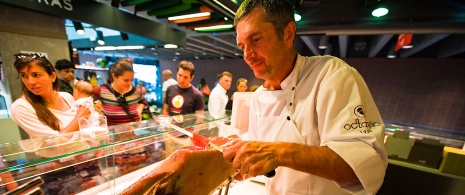
Within everyone's reach
One of the characteristics of the Spanish haute cuisine is that it strives to reach a very wide-ranging audience, to democratize fine dining as much as possible. For example, there are well known restaurants in the Michelin Guide that offer set menus for under 30 euros. There are even some more exclusive dining options that are situated within accessible price ranges. In addition, haute cuisine in its strictest sense -world famous high-end restaurants with flawless standards- have expanded into other areas and today it is possible to enjoy one of their signature dishes or tapas, made with top quality ingredients and sophisticated techniques, in many gastrobars and taverns. Do you need any more reasons?
Travel plans for inspiring you













